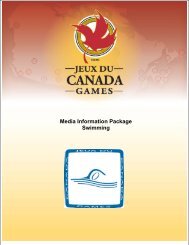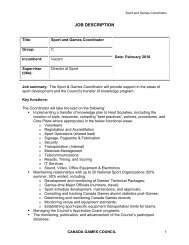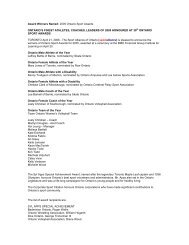Targets for Athlete Performance and the Sport System
Targets for Athlete Performance and the Sport System
Targets for Athlete Performance and the Sport System
You also want an ePaper? Increase the reach of your titles
YUMPU automatically turns print PDFs into web optimized ePapers that Google loves.
than innovation, with respect to <strong>the</strong> cutting edge equipment research <strong>and</strong> innovation that is required<br />
to be internationally competitive. The result is that Canada risks losing ground in many sports that<br />
are equipment intensive (speed skating, bobsleigh, canoe, kayak, rowing etc). Data regarding<br />
athlete results, training, <strong>and</strong> competition is not collected <strong>and</strong> shared in a systematic way.<br />
Knowledge management, <strong>the</strong> cornerstone of <strong>the</strong> new economy, <strong>and</strong> <strong>the</strong> new area of international<br />
sport, is an area in which Canada is particularly weak.<br />
Recommendations: The desired actions <strong>and</strong> outcomes in this area require centralized<br />
planning <strong>and</strong> <strong>the</strong> involvement of NSOs, PSOs, <strong>and</strong> <strong>the</strong> F-P/T funding partners. Canada must lead<br />
<strong>and</strong> participate in domestic <strong>and</strong> international sport policy research. It also needs to identify,<br />
prioritize, <strong>and</strong> invest in Applied <strong>Sport</strong> Research (ASR) <strong>the</strong>mes, with <strong>the</strong> research being coordinated<br />
through <strong>the</strong> Canadian <strong>Sport</strong> Centres. Applied <strong>Sport</strong> Research Institutes (ASRI) in each of <strong>the</strong> three<br />
general areas below should be created <strong>and</strong> funded:<br />
• ASRI <strong>for</strong> Resistance <strong>and</strong> Friction (skating, bobsleigh, luge, skeleton, skiing<br />
applications)<br />
• ASRI <strong>for</strong> Endurance (athletics, cycling, triathlon, cross country skiing applications)<br />
• ASRI <strong>for</strong> Speed <strong>and</strong> Power (athletics, hockey, basketball, skating, diving<br />
applications)<br />
<strong>Sport</strong> organizations, <strong>and</strong> <strong>the</strong> national funding partners should partner with universities <strong>and</strong><br />
major Canadian research funding agencies to create a capacity <strong>for</strong> applied sport science research.<br />
The research <strong>the</strong>n must be used <strong>for</strong> innovation in athlete training, preparation <strong>for</strong> competition <strong>and</strong><br />
equipment development. Data regarding athlete results, per<strong>for</strong>mance <strong>and</strong> training should be<br />
collected in a systematic way <strong>and</strong> integrated telecommunications technology should be used to<br />
manage <strong>the</strong> knowledge <strong>and</strong> share it across <strong>the</strong> sport system so that it can be used <strong>for</strong> intervention in<br />
training, preparation <strong>for</strong> competition <strong>and</strong> equipment development.<br />
2. Talent Identification <strong>and</strong> <strong>Athlete</strong> Monitoring<br />
An effective system <strong>for</strong> <strong>the</strong> statistical identification <strong>and</strong> monitoring of <strong>the</strong> progress of<br />
talented <strong>and</strong> elite athletes exists in <strong>the</strong> successful international sport nations. Australia, <strong>for</strong><br />
example, has a program in which children undergo systematic voluntary general athletic ability<br />
testing in <strong>the</strong> schools. The <strong>Sport</strong> Search program is used to identify children (9-12 yrs old) with<br />
athletic ability. A second program, Talent Search, involves more sport specific testing at <strong>the</strong> older<br />
age groups (12-15) <strong>and</strong> has <strong>the</strong> objective of identifying young athletes with sport specific abilities.<br />
The province of BC has developed a generic talent identification system <strong>for</strong> winter sport (<strong>Sport</strong> Fit)<br />
that has involved voluntary general athletic ability testing of approximately 2,000 children to date<br />
<strong>and</strong> a database of <strong>the</strong> results has been created.<br />
O<strong>the</strong>r than <strong>the</strong> system in BC, <strong>the</strong>re is a lack of a system <strong>for</strong> <strong>the</strong> identification of general<br />
athletic ability <strong>and</strong> sport specific talent in Canada. For many sports, <strong>the</strong>re is only a small pool of<br />
talented athlete which rise to <strong>the</strong> top via completely r<strong>and</strong>om chance of a young athlete or <strong>the</strong>ir<br />
parents enrolling in <strong>the</strong> correct sport.<br />
Recommendations: The desired actions <strong>and</strong> outcomes in this area require coordinated<br />
planning <strong>and</strong> <strong>the</strong> involvement of NSOs, PSOs, <strong>and</strong> <strong>the</strong> F-P/T funding partners. First, a common<br />
taxonomy <strong>for</strong> athlete level is required so that <strong>the</strong>re is a common underst<strong>and</strong>ing of terms like Age<br />
<strong>Athlete</strong> Per<strong>for</strong>mance <strong>and</strong> <strong>Sport</strong> <strong>System</strong> <strong>Targets</strong>, Evaluation, <strong>and</strong> Investment Page 30





